The latest report from California New Car Dealers Association (CNCDA) shows total new light vehicle registrations for the first three quarters of 2021 rose 23.8% compared to the same period in 2020, but were still off 6.6% compared to the same period in pre-pandemic 2019. Overall, the latest projections expect a gradual recovery in total sales, rising to 1.85 million for 2021 and 1.91 million in 2022, compared to 1.64 million in 2020 and 2.09 million in 2019. These numbers, however, remain subject to uncertainty stemming from the continuing supply chain disruptions and their effect on both imported vehicle deliveries and component shortages affecting domestic production.
Fiscal Impact from Lower Sales: $1 billion
While improving over last year’s slump, the projected 2021 sales would be the lowest since 2013, an indicator of the extent of the current effects of the COVID-related shutdowns on jobs and incomes within this retail sales industry along with the substantial number of related jobs up and down the production, distribution, and maintenance chains. The lower level of sales in this traditional component of the economy also has a significant effect on state and local revenues. Using average factors to estimate the direct effects from the expected drop-off compared to 2019, the loss in sales and use tax revenues is an estimated $890 million, and registration fees—currently 14 different fees imposed by the state on new vehicle purchases—are off by another $136 million. Additional revenue shortfalls also stem from lower business and personal income tax receipts.
The current supply chain disruptions, the most visible of which is the continuing high levels of congestion at the state’s ports, are having major effects on households and businesses through supply shortages and the contribution to growing inflation. These estimates indicate there is a fiscal cost to state and local governments as well.
The state is experiencing record high levels of general fund revenues, but these estimates also illustrate the extent to which these surpluses are coming from the higher wage and to a high degree the high tech components of the state’s economy, while the traditional middle class wage elements have been harder hit by shutdowns during the pandemic period. These estimates also illustrate one of several components in the current state and local fiscal models that will be affected as state agencies continue policies to force Californians out of the use of individual vehicles.
These revenue impact estimates are based on the July average transaction price for new vehicles available at the national level. Average prices overall have been climbing to new records both as the result of ongoing supply shortages, but also the continuing shift of consumers to more expensive SUVs and pickups. The same effect, as discussed below, is present in California, with the shift to higher cost vehicles in particular accelerated due to the fact that higher wage workers substantially have retained their jobs throughout the pandemic period, while the effects of the state-ordered closures have fallen more heavily on the lower ranks.
Used Car Prices Rise 39% During Pandemic Period
Supply and price conditions within the new car market also have an immediate effect on prices within the used car segment as consumer demand is shifted. In the current circumstances, the effects have been further magnified by the wholesale abandonment of public transit and the consequent need for some workers to secure commute alternatives.
Applying the same calculations used by Department of Finance to develop the California CPI to the used car component, used car prices have spiked 39% during the pandemic period, the same seen when looking at the national numbers. This outcome, however, is more striking given that the CNCDA report indicates new registrations have been especially stronger for older used cars, with vehicles aged 7 to 10 years up 26.0% (2021 YTD through September vs. 2020 YTD), those aged 4 to 6 years up 21.0%, and 3 years or newer down 2.9%. Many lower wage workers had to secure commuting alternatives quickly, but also had to pay more for the change.
But while the used car price effects have been similar in California and the US under the current circumstances, these results can be used to illustrate future conditions likely to affect only the state. Under California policies to require 100% ZEV sales by 2035, the state runs the risk of recreating comparable supply and price effects, both as new vehicle offerings shift to higher price ZEV models along with a potential additional component coming from the need to replace battery packs in many used ZEV models. Nationally, used vehicle prices are likely to return to their prior more stable level once market conditions resume closer to normal. California policies instead will continue to be a source of uncertainty in the outcomes.
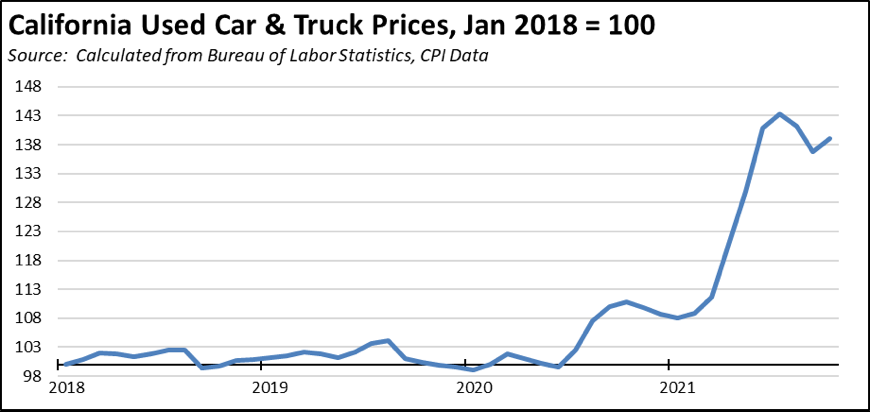
Light Trucks Continue to Dominate New Vehicle Sales
One of the barriers to stronger market penetration by electric vehicles has been until recently the fact that most electric models have been within the car segment, while consumers have moved more to light truck models, a trend that has been even stronger on the national level. Consumer preferences again were heavily tilted towards light truck models. In California, trucks were 65.6% of new light vehicle registrations in the 3rd quarter and 65.7% year to date, while the comparable share for the rest of the US year to date was 78.4%.
In fact, while total new light vehicle registrations are down, the new truck component has continued to grow. The drop in overall new vehicle registrations compared to pre-pandemic 2019 and even compared to the higher sales in 2018 stems solely from fewer new cars being sold. Overall comparing third quarter YTD results, new car registrations were down 161,453 from 2019 (down 174,143 from 2018), but new trucks were up 56,672 from 2019 (up 154,663 from 2018).
Producers have begun offering electric truck models but so far primarily in the smaller size segments. For instance, the CNCDA report indicates the Tesla Model Y led sales within the luxury compact SUV segment to date in 2021. Others are now beginning to expand to the larger truck models consumers are buying, but while these offer comparable ranges under normal driving conditions, range issues may still arise when operating under load.
The shift to electric truck models, however, presents its own challenges to consumer costs within the broader vehicle market. For most if not all domestic automakers, the light truck segment produces the bulk of company profits. This outcome is due to its larger size in overall sales, but light trucks also carry higher margins that in essence provide internal subsidies for production of smaller cars and other vehicles including electric vehicles necessary for regulatory compliance purposes, both for California emission rules and national fuel efficiency standards. Tesla—the only major company to provide this information directly—illustrates the overall importance of this factor. In its most recent 10-Q filing, the company reported $1.15 billion in revenues from the sale of regulatory credits in the first three quarters of 2021, both credits created for the company from the California and the national rules, or nearly a third of its reported income before taxes. In the same period for 2020, regulatory credits generated $1.18 billion, or 152% of income before taxes. As higher cost electric trucks erode this margin base, consumer prices overall will have to adjust to maintain profitability.
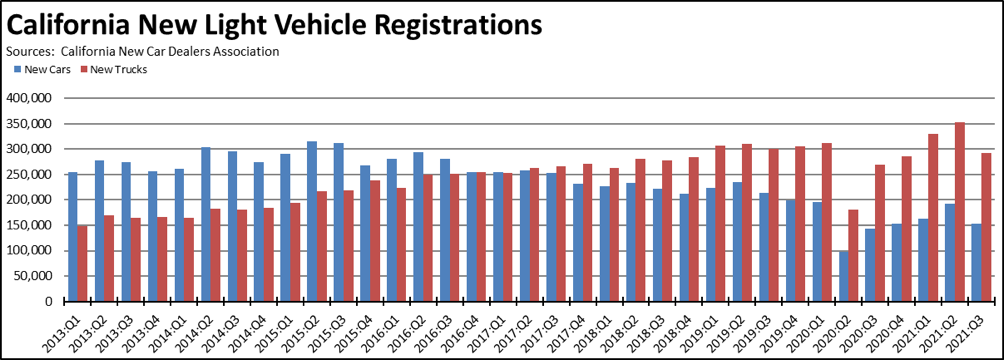
ZEV Sales Up 68.4%
Source: Derived from California New Car Dealers Association
- New registrations for battery vehicles moved up strongly in 2021 year to date, with ZEVs (BEV—battery electric vehicles) rising 68.4% and PEVs (plug-in vehicles) rising 127.0% as the combustion engine component—plug-in hybrids (PHEVs)—continued to show the most variability. The 2020 base, however, had numbers roughly comparable to or lower than the same period in 2019 due to pandemic factors. Consequently considering the 2021 results as a 2-year increase incorporating delayed purchases places the growth rates more consistent with the longer-term trend for BEVs since 2018, with the hybrid components showing higher variability. Fuel cell electric vehicles (FCEV) remain at negligible numbers, about 2,500 in the nation as a whole.
- Total new registrations in part reflect the growing number of models being offered in this segment. Tesla, however, accounted for 67% of new BEVs, essentially the same level as the comparable period in 2020. Considered from this perspective, the range of financial and regulatory incentives now offered and to be developed by the state continue to accrue largely to a single producer.
- Market shares for BEVs, PEVs, and HEVs reached new highs, although these results are heavily affected by the overall lower level of total new registrations in 2020 and so far in 2021. While the current results show relatively more rapid growth in market share, the acceleration going forward is likely to dampen as the underlying base of total light vehicle sales recovers to pre-pandemic levels.
- Not all ZEVs shown in the CNCDA results remained in California. Comparing this report with the Energy Commission’s sales data derived from DMV records, about 18% of the CNCDA registrations did not remain in the state. Some of this discrepancy, however, may be due to pandemic factors. Low dealer inventory throughout the country may mean that out-of-state buyers turned to California where ZEVs are primarily marketed. Alternatively, the ability of these higher income buyers to telecommute in this period may have seen ZEVs being moved as these household moved to lower cost locations in other states.
- While the current results show improved results for battery vehicles, a number of factors may be affecting the outcome. Whether the 2021 trends are sustainable, consequently, will become more apparent in the subsequent quarters particularly as overall sales recover. These factors include:
- Much like the state’s policies seek to apply on a more restrictive level in the years going forward, the past three quarters have seen sharply lower supplies of vehicles overall as the result of supply chain disruptions affecting the deliveries of finished vehicle imports along with parts and components required for domestic production. Consumers currently are buying what’s available on the lots, and dealers currently are faced with historically low inventories. Sales of battery vehicles may be up because there are fewer traditional alternatives available.
- The effects of the state-ordered shutdowns have heavily hit lower income households. Higher wage earners have been far less affected in large part due to the rapid shift to telecommuting and other employer adjustments to the pandemic circumstances. Higher income households more able to afford the higher cost electric vehicles and higher price vehicles overall consequently have been a higher presence in the current vehicle buying market. This situation is illustrated by the fact that Tesla showed the biggest increase in sales (2021 through September compared to 2020 through September), while Porsche came in second.
- The collapse in public transit ridership has forced those commuters to find alternative means of transportation. As discussed above, lower income workers likely have turned to the used car market. Higher income commuters including much of the former rail ridership by choosing public transit already had a predisposition to alternative transportation modes. The market segment is still likely experiencing the effects from an influx of this type of consumer, particularly as an increasing number of companies have shifted back to in-office on a full or hybrid schedule while public transit ridership remains at severely depressed levels.
- After declining throughout much of 2020, the monthly average price of regular gasoline rose 24% through September 2020, or by $1.19 a gallon, to its third highest level since at least 2000. The resulting effect on more fuel-efficient vehicles is seen particularly in the jump in new registrations for battery hybrids (HEVs). While state regulations and policies likely will continue to exert upward pressure on gasoline prices, the cost to California motorists is also affected by world oil prices. A period of price easing or stability would reverse some of this incentive for battery vehicles.
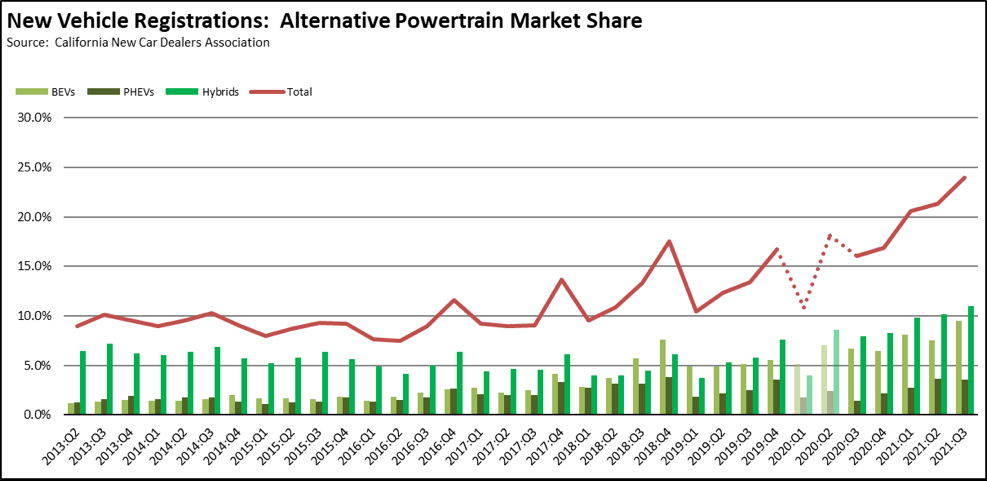
State Goal: 100% ZEVs by 2035
The state previously maintained a goal of 5 million zero-emission vehicles (ZEVs) on California roads by 2030 pursuant to Executive Order B-48-18. Under Executive Order N-79-20, the governor changed this goal to require all new vehicles offered for sale in the state to be ZEVs by 2035 for light duty cars and trucks, and by 2045 for heavy and medium duty vehicles. In spite of the substantial but as-yet unknown costs and other effects of this action, the state agencies are now moving ahead to implement this order using the blanket authorities given to them by the legislature under the climate change program.
California’s sales mandates for ZEVs first began with the Air Board’s adoption of the LEV I regulations in 1990. After three decades, these mandates have resulted in ZEVs comprising 8.3% of new light vehicle registrations as measured against the diminished sales base in the first three quarters of 2021. Even assuming the higher market share values produced by the lower sales base in 2020 and 2021, the current trendline estimated from a regression of the data to date indicates these vehicles are currently on track to be only half of sales by 2035. Substantial deviation from trend would have to begin prior to 2027 in order to meet the 2035 goal, but likely sooner given that the current market share values are artificially high given the various pandemic period factors. In other words, evaluation of the likelihood of achieving the 100% by 2035 goal and the likely costs of getting there can be measured substantially by what the state does in the next 4-6 years.
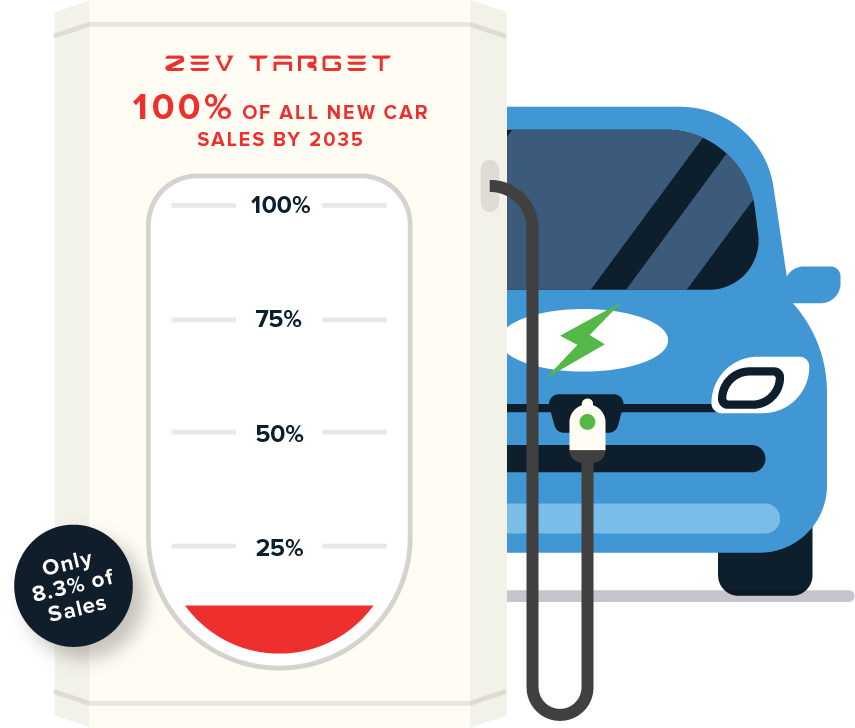
Consistent with this policy, California recently signed on to two agreements completed as side activities at the recent COP26 in Scotland. The COP 26 Declaration on Accelerating the Transition to 100% Zero Emission Cars and Vans calls for working towards having sales of new cars and vans be 100% ZEVs globally by 2040 and by 2035 in leading markets. The Memorandum of Understanding on Zero-Emission Medium- and Heavy-Duty Vehicles calls for developing pathways to enable these vehicles to reach 30% of sales by 2030 and 100% in new fleets by 2040.
Rather than binding agreements to achieve these goals, however, both documents basically call for studies and cooperation on how these goals could be reached rather than specifying they will be reached. Specifically, the first Declaration states that “this declaration is not legally binding and focused on a global level.” The MOU states that “is not an international agreement and does not create any legally binding rights or obligations between or among the Participants.”
While media reports at the time of signing tended to focus on who signed on to these agreements, more telling was who did not. The MOU eventually garnered the signatures of only 14 nations. Combined, the nations signing on to the Declaration represent only 14% of global light vehicle production in 2020. Participating auto producers cover only 6 units or companies within the 50 largest producers globally, and does not include the current leading electric producer in the US, Tesla. While these agreements represent a framework for the state to work with like-minded parties as it develops its policies, the signatories willing to go even this far indicate the extent to which California largely remains an outlier in deciding that the current state of technology warrants moving immediately to an 100% sales mandate. The largest global producer, Toyota, recently announced a shift to producing roughly 30% of its output as electric vehicles by 2030, but remains committed to producing a diversified range of vehicles in addition to continued development of other technologies such as hydrogen given the current uncertainties—including costs, materials availability, and consumer acceptance—related to a premature commitment to electric only.
State Goal: Challenges
While the number of complying models being offered by producers continues to increase, further progress towards the 100% by 2035 goal continues to face a number of challenges.
Consumer Acceptance. While obviously improving due to the increasing sales numbers, broader consumer acceptance of the technology has yet to take hold. A recent study by researchers at UC Davis found a high level of PEV consumers switching back to gasoline vehicles after their first purchase—18% of BEV buyers and 20% for PHEV buyers. Women in particular were found to be more likely to abandon the technology after they tried it as were households that did not have other gasoline-powered vehicles available. This latest study adds on to other recent research suggesting that the currently expected emission reductions from a ZEV mandate are greater than what is being realized, including: (1) research indicating that on average ZEVs are driven less than half as much than currently modeled, and (2) other papers indicating that even households buying a BEV typically often then feel justified in buying a larger, less fuel efficient vehicle for longer travel and for trips requiring vehicles of this size.
Sales Remain Highly Concentrated. While market shares are increasing, sales remain highly concentrated, in particular within the higher income coastal cities in California.
By state, California contained 36% of all ZEV (BEV and FCEV) sales in the first half of 2021, followed by Florida at 7.8%, Texas at 5.6%, and New York at 4.7%. Only two other states (Washington and Hawaii) along with DC had a ZEV market share above 5%. In the broader period since 2011, 43% of all ZEVs sold have been in California.
In contrast, hybrids were more disbursed, with California containing only 21.9% of national sales in the first half of 2021. And at total sales in the first half at 573,535 compared to ZEVs at 209,206, the flexibility of the combustion components in the battery model offerings continues to attract broader consumer acceptance nationally just as it does in this state.
The high degree of concentration within California can be illustrated by the number of registered ZEVs by legislative district. Estimates are calculated from Energy Commission data summarizing registered vehicle types by zip code as obtained from DMV records, using the most current data for 2020.
Overall, Californians remain open to some degree to alternative technology vehicles, but ZEVs remain near the bottom as the preferred choice. In 2020, gasoline comprised 87.4% of all registered vehicles, followed by hybrids at 5.0% (HEV 4.0%, PHEV 0.9%), flex fuel 3.9%, diesel/bio diesel 2.4%, ZEVs 1.3%, and natural gas/propane at less than 1%.
In the following charts, the districts are ranked by the share of total ZEV/Hybrid registrations in 2020, with the dotted lines indicating the outcomes if each district instead had the same number of these vehicles as a benchmark showing how skewed the current distribution is. Only 17 (21%) of Assembly Districts and 9 (23%) Senate Districts contained half of the total ZEV registrations. Similarly, only about half the districts in each house contained 80% of total ZEVs.
Despite the highly concentrated locations of these vehicles, both state and ratepayer funds are currently being used to develop recharging networks to enable them to move more freely around the state. Owners of the 98.7% of vehicles that are not ZEVS consequently pay through their electricity rates to develop this recharge network for the 1.3%, while also continuing to pay to maintain the existing fueling network through their periodic purchases.

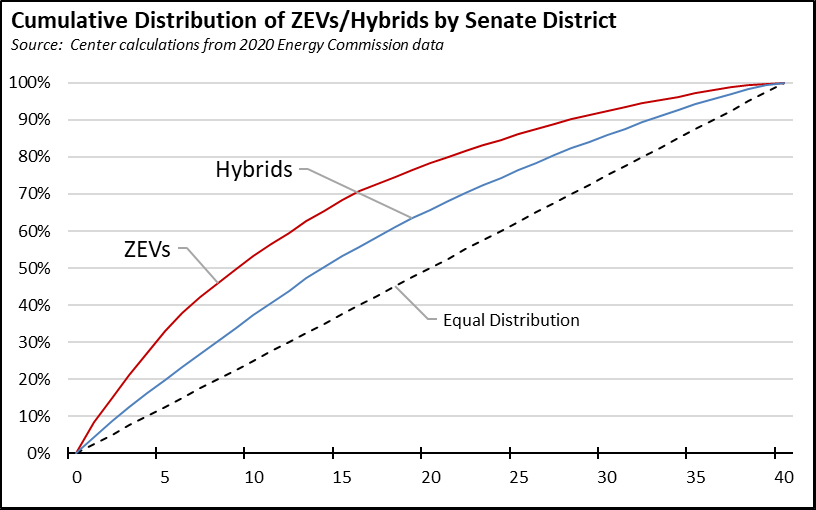
Measured as a share of total registered vehicles, only 16 Assembly Districts and 9 Senate Districts show ZEVs at or above 2%. Only 7 Assembly and 3 Senate are above 3%.
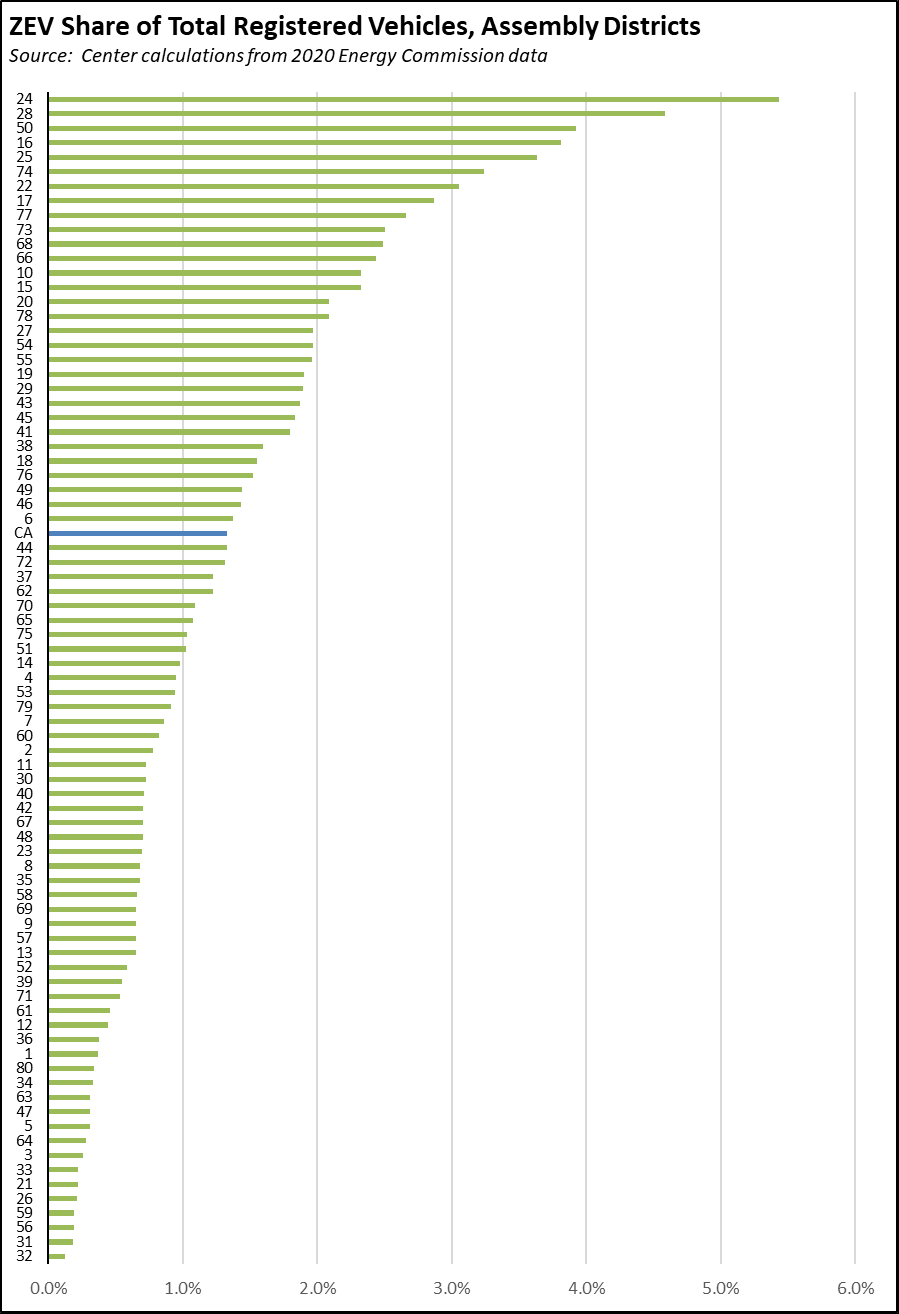
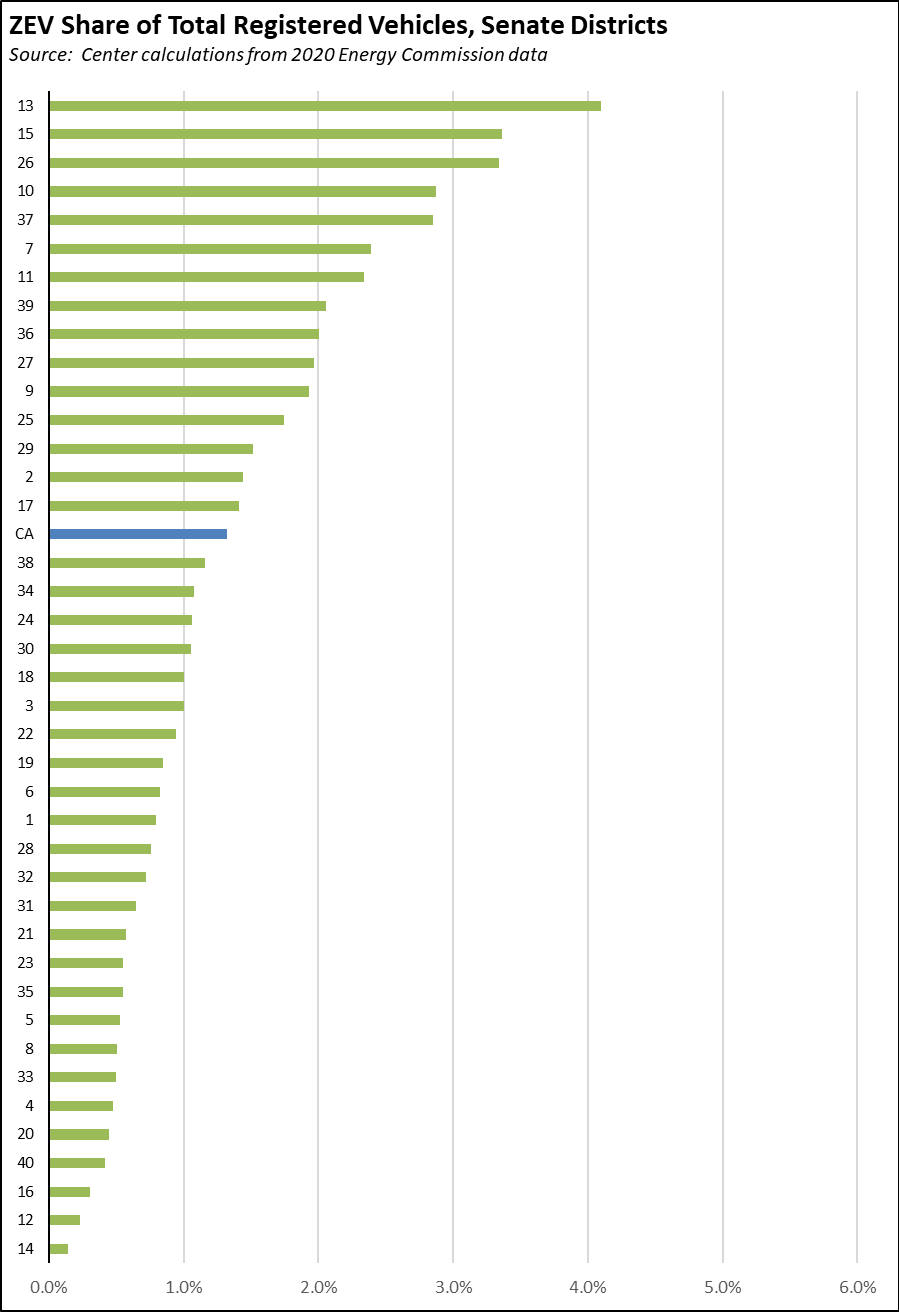
Uncertain Future for Subsidies. Both state and federal and some local policies have been developed around the concept that consumers will not buy the higher cost ZEVs unless public subsidies are there to get them to buy. California’s system has gone through several iterations. As the provisions have changed and qualifications have become more restrictive, these subsidies have become less significant particularly for the sale of the higher priced ZEVs, as indicated in the estimates contained in the following chart.

On the federal level, the current tax credits are having even less an effect. From the national sales estimates for ZEVs, vehicles from the leading two producers—Tesla and GM—no longer qualify. Yet, combined these two brands accounted for three-quarters of all ZEVs sold in the first three quarters of 2021, Tesla alone at 68%. Ford while still qualifying for credits, benefited more from its electric vehicle debut in the vehicle class of most interest to buyers, with its Mustang Mach-E SUV that immediately leapt into third place and outsold the next two largest ZEV producers combined.
The current federal subsidy framework contained in the House version of the Build Back Better bill has even less certain potential as the purely economic incentive originally intended in this policy tool has become burdened by an increasing number of social and political policy factors. The only current ZEV model that would meet all of the qualifications for the full federal credit as it is now proposed, is the Chevrolet Bolt. And even that vehicle is not being sold or produced at the moment given the ongoing halt in production due to its recall for battery fires. Adding further uncertainty to its potential effects on overall sales, the current proposal if enacted is also likely to be challenged as a violation of existing trade treaties, running counter to the professed intent to promote adoption of ZEVs on a more global scale.
Rising Recharging Costs. A continuing contention voiced in support of electric vehicle mandates has been that as the cost of batteries declines over time, the remaining cost differential between an electric and traditional fueled vehicle will be more than offset by longer term savings in fuel and maintenance costs. Putting aside the issue that getting to this point still requires consumers to pay these 10 or more years’ worth of operating costs up front, the potential offset in California is being rapidly displaced by the state’s soaring electricity costs.
This effect can be seen from an example comparing the two top models in the first three quarters in the luxury compact SUV segment, the electric Tesla Model Y followed by the gasoline Lexus NX. The difference in average MSRP is about $19,000. The annual fueling costs based on an average 12,500 miles driven per year are shown in the following tables using the monthly average electricity and gasoline costs in 2010 when the state first began implementation measures under its climate change program, 2020, and 2021 to date during a period of rising oil prices.
In the table, the electricity costs are the 12-month moving average residential rates derived from Energy Information Administration data. While prior analyses generally assume most ZEV recharging will occur using lower off-peak rates, the average is used due to two factors. First, the current policy to incorporate more intermittent solar and wind generation will shift time of day cost lows more to the peak daytime hours while also raising off-peak costs due to heavier reliance on higher cost storage. Second, expansion of recharging networks combined with increased telecommuting will shift both the times and locations of recharging. In the case of recharging networks, California’s average commercial rate has grown even faster to $0.188 per kWh in the latest data, the highest among the contiguous states. Recharging station rates will also vary, for example, EVGo currently shows rates of $0.25 to $0.39 per kWh depending on location within California. Rather than attempting to address all these factors, the average residential rate is used to provide a simpler example illustrating the effect of the state’s rapidly rising electricity costs since 2010.
Present value in the table is based on 10-years’ worth of savings assuming the differential remains as shown. This savings stream is discounted using a current average of auto loan rates for buyers with good and excellent credit to indicate how much of the $19,000 cost differential would be offset by the difference in fuel costs alone.
The results using California costs for both gasoline and electricity are shown in the following table. While gasoline prices have grown, the potential savings from shifting to an electric vehicle have largely been offset by the equally rapid rise in electricity rates. In the absence of rising world oil prices over the past year, the potential offset from fueling costs would have continued to erode.
The impact of state policies driving higher electricity rates can be illustrated by instead running the numbers using the average residential rate for the rest of the US. In 2010, the average rate for the other states was $0.113, only slightly lower than the results in most recent data. State policies that would have more closely considered costs and kept rates closer to the far more stable national experience would have instead produced a much stronger incentive for a shift to electric vehicles. These two components of the state’s climate program instead are working at cross purposes.
The results in the previous two tables, however, rely heavily on another outcome of the state’s climate change and tax policies, namely actions that have also increased prices for the 98.7% of total vehicles wholly or partially using traditional fuels. Instead, using California electricity costs compared to the average gasoline costs in the other states shows that the potential incentive for electric vehicles is slashed to less than half.
California has been able to maintain an incentive for higher income ZEV buyers only by raising the costs on everyone else. And as electricity rates are projected to rise further by around another 40% between 2020 and 2030, pressure on the incentive shown in these tables will only increase as well.
Broader state policies, however, largely anticipate these trends, but assume that as people are priced out of personal vehicle use, they will instead turn to heavier use of public transportation. The current state transportation spending priorities and an increasing set of regulations such as VMT penalties on housing reinforce this shift.
The numbers, however, strongly indicate these policies are not working. In spite of a major shift in capital spending to system expansion, public transit ridership was dropping even prior to the pandemic period. As measured by unlinked passenger trips (UPT), ridership dropped 15.5% between its peak in the second quarter of 2014 through the end of 2019. Ridership then plunged another 60% at the beginning of the pandemic, and through the second quarter of 2021 recovered to only 37% of the prior peak level.
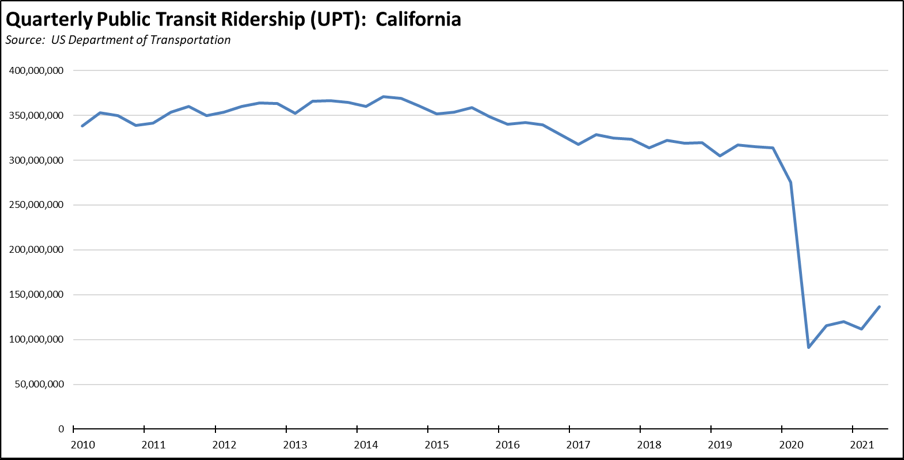
And while multiple state regulations are now trying without success to reduce Vehicle Miles Traveled (VMT), Passenger Miles Traveled (PMT) on public transportation dropped instead. In 2019 prior to the pandemic, PMT was down 8.1% from its peak in 2015 despite local, state, and federal investments to expand the geographic coverage of public transit. In 2020, PMT had plunged 28.9% from its peak level.

Public transit has not worked for the vast majority of California commuters because the state housing policies work against its intentions. In particular, lower income workers are forced into broader search areas for both jobs and housing they can afford. Public transit instead relies on core concentrations especially of white collar jobs such as in New York City and San Francisco which makes it more feasible for this class of workers to use.
In fact, the only significant shift in the use of single occupant vehicles has come from the pandemic-induced acceleration in the number of workers working from home. Use of public transit and other policy-preferred modes such as walking and biking (included in Other) instead has largely depended on a shift away from carpools—workers already amenable to using the commute alternatives state policies have tried to promote but a relatively small universe of workers already predisposed to adopting to these changes.
State policies instead have served only to increase the cost of commuting, in particular lower wage households dependent on their vehicles.
Commute Mode, California
Source: American Community Survey
Note that in the table, the 2020 American Community Survey results have been released as “experimental data tables” due to response issues related to conducting the survey during the pandemic period. While the 2020 results are not strictly comparable with prior years, they indicate the general trend in the data.

